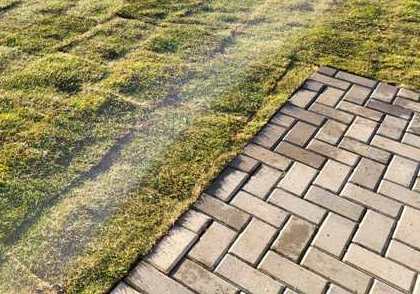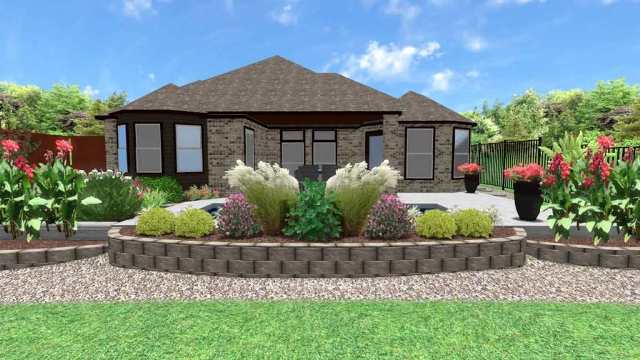
solvida
Best Lawn Edging for DIY Installation
Lawn edging plays a critical role in your landscaping. Regardless of the type installed, all landscape edging creates a necessary grass barrier between your lawn and planting areas. This edging will help prevent grass from growing into your garden bed while also giving you an easy way to edge the lawn. In the selection process to find the best lawn edging for DIY installation, you should consider both form and function.
Types of DIY Lawn Edging:
- Metal Edging
- Composite Bender Board Edging
- Brick Edging
- No-Dig Rubber Edging
- Natural Lawn Edging
- Wood Edging
- Concrete Edging
Metal Edging
Metal edging is available in a variety of colors: brown, black, green, silver, and raw metal. It can also be purchased in both 4” and 6” heights. You can also find metal edging in a variety of finishes: powder coated, painted, raw, and galvanized. Metal edging is most commonly found in 8’ or 10’ lengths. All metal edging comes with steel stakes for easy installation and connecting to other pieces. It is flexible, allowing for curved installations, and fairly inexpensive when compared to the cost of installing stone landscape edging. The only real downside to metal edging is that it rusts over time, can feel sharp when stepped on, and is difficult to cut and bend without special tools.
Composite Bender Board Edging
Composite bender board edging is made primarily of recycled plastic. This lawn edging comes in either black or brown and is found at either 4” or 6” height. Composite edging is sold in 20-foot lengths. It is flexible, rot-resistant, and sturdy, with a thickness of about 1” making it ideal for edging flower beds, and it is even used as a border for artificial turf areas. Bender board edging is installed directly into the ground with either j-hook stakes or stakes with screws, and pieces are attached together with screws. Composite bender board edging is easy to install and is more durable than metal edging.


Brick Edging
Bricks are a lightweight and inexpensive lawn edging material. They are available in endless varieties of colors and can most often be found locally to match your home. Most often, brick edging needs to be installed level. This may require some trenching, concrete, and mortar work, which is sometimes best accomplished by hiring a stone mason. If you prefer to have bricks without holes, look for concrete paver bricks. These are larger, heavier, and require less stacking.
No-Dig Rubber Edging
No-dig rubber edging is a great DIY edging option, requiring very little experience and a few tools. Rubber edging comes in lightweight, 4’ sections. Each section is manufactured with a 90-degree angle and predrilled holes for stakes, so no digging is required. It’s both long-lasting and available in a variety of colors: brown, green, red, gray, and black. While it costs more compared to other edging options, it lasts longer and takes less maintenance than steel or wood edging.
Natural Lawn Edging
Natural lawn edging is achieved without any artificial barrier; it is simply an edge between your lawn and garden bed. It’s incredibly economical, as it only requires a shovel. However, it will require your attention from time to time to keep the edge up and the grass out of your garden bed.


Wood Edging
Wood is another option to create yard edging. Examples of commonly used wood edging would be railroad ties, landscape timbers, and cedar wood rolled edging. When wood comes into contact with moist soil for long periods of time, it can rot and attract unwanted pests. However, cedar wood is naturally rot- and pest-resistant. Landscape timbers are also pressure-treated to prevent rot and pests. Railroad ties are even treated with creosote, which prevents rot, termites, and fungus. All of these wood-edging options are effective.
Concrete Edging
A pre-formed concrete edging creates an incredibly durable and long-lasting landscape edging. Concrete edging is available in several colors and a variety of shapes to complement any landscape design. Although concrete edging is certainly heavier than other edging options, it comes in smaller pieces, making it much easier to transport and handle. Concrete edging is also available in both straight and curved pieces.
Frequently Asked Questions About Installing Lawn Edging
How to install steel landscape edging along a sidewalk?
Dig a trench next to the sidewalk edge. Secure metal edging by inserting stakes through the edging directly into the ground. Pack dirt around the outside of the metal edging to push towards the sidewalk, leaving no gap.
How do you hold lawn edging in place?
Dig a 1” trench at least the width of the edging. Place the edging in the trench and hold it in place using stakes.
How to install no-dig landscape edging?
Although not necessary, it’s best to remove a small strip of grass beneath where the edging will be installed. Position the edging and simply hammer the stakes into the ground through the pre-drilled holes.
How do I straighten rolled plastic garden edging?
Unroll the plastic edging and leave it in the sun until the plastic softens.

